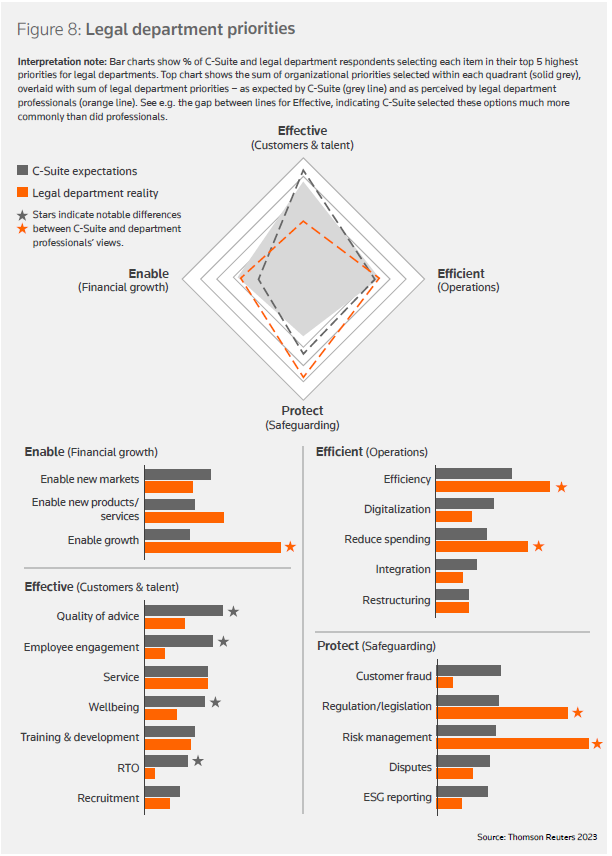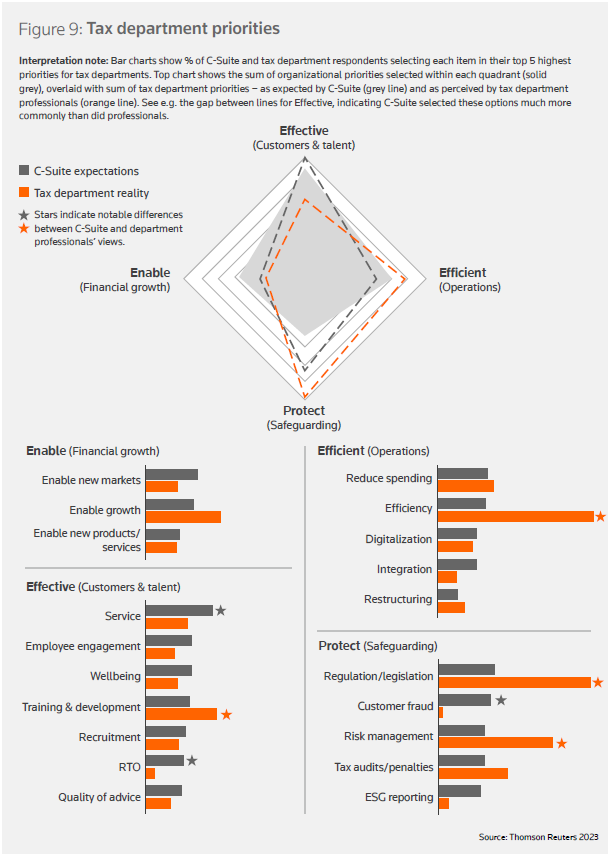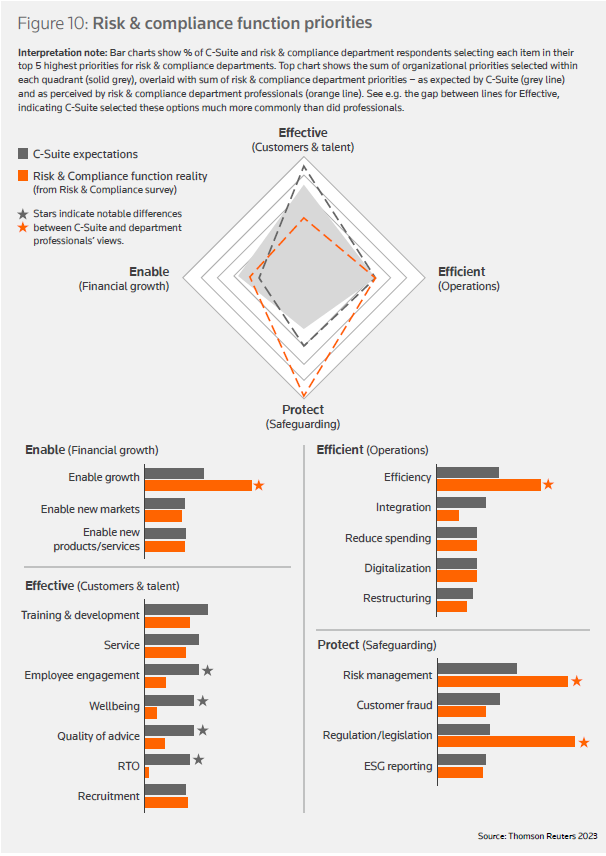C-Suites have different business priorities than their legal, tax and compliance departments, and those differences could have ramifications for how companies can effectively implement generative AI technology
No matter where one sits within the corporate structure —whether in the legal, tax, or risk & compliance function or in another department — there remains one goal: operate in the best interests of the business. And by and large, these departments have become accustomed to making decisions with their companies’ business interests in mind, spurred on by fluctuating economic conditions and increasingly complex regulatory and technology environments.
In practice, however, those departments may not conform with the C-Suite about which aspects of the business to actually prioritize, according to a recent study. Thomson Reuters’ recent Future of Professionals: C-Suite Survey revealed that while the C-Suite is much more focused on customers and talent, companies’ legal, tax and compliance functions have focused their priorities in other areas — particularly safeguarding the business.
The result is that when adopting new technologies such as artificial intelligence-enabled services, C-Suite executives and these department leaders may not be on the same page about how to approach AI’s opportunities and risks.
Differing priorities
The C-Suite Survey broke down an organization’s goals into four distinct buckets: financial growth, operations, customers and talent, and safeguarding the business. Naturally, the idea is that a corporation would perform all four of these actions at once, acting in perfect harmony. In the real world, however, budgetary and time constraints mean that some of these goals take priority over others.
For much of the C-Suite — especially for non-CEO members — actions in the customers and talent bucket were of the highest priority, followed by operations and financial growth, with safeguarding the business bringing up the rear. The customers and talent focus spans various types of priorities as well: Among all C-Suite members, 43% said that customer satisfaction was among their top five business priorities; brand/reputation management came it at 35%, employee engagement at 34%, and recruitment at 29%.
If you ask those C-Suite members, of course, they believe their business units feel the same way. When asked on a five-point scale how aligned they thought their business units are with the organization’s overall goals (with 5 being very aligned), C-Suite members gave a perfect very aligned score to 53% of legal departments, 48% of risk & compliance departments, and 45% of tax departments. The C-Suite also gave a score of either 4 or 5 to those departments at 92%, 93%, and 88% of the time, respectively.
The problem is, however, those business units’ answers of their own priorities don’t actually reflect the C-Suite’s perception. Take for example, the legal department. While the C-Suite ranked safeguarding the business as their lowest priority out of the four given buckets, respondents from legal departments themselves said it that was the highest priority, particularly around regulation/legislation risks and risk management.
That may not be a surprise, given the legal department’s role in the organization. Perhaps more interesting is that respondents from legal departments also ranked financial growth higher than did C-Suite respondents, particularly around making decisions to enable growth. Legal departments’ focus on customers and talent, meanwhile, ranked much lower than C-Suites had envisioned.

Similar differences emerge when looking at responses from corporate risk & compliance department respondents. Once again, safeguarding the business ranks as the departments’ top priority, differing from C-Suite priorities. In this case, however, risk & compliance departments also have a higher interest in operations and particularly efficiency than does the C-Suite. Further, risk & compliance departments don’t care about customer service or return-to-office policies at nearly the same level as C-Suites seem to perceive.

Finally, tax departments represent a middle ground between the previous two comparisons. While their operations and financial growth priorities are similar to what the C-Suite sees, the customers and talent and safeguarding the business priorities are essentially inverted compared to the C-Suite. In the tax function’s case, a high priority on risk management and regulation/legislation puts safeguarding the business first, while a low priority on employee engagement, well-being, and quality of advice strongly differs from the C-Suite.

The AI conundrum
These differences could have a number of significant ramifications across the business, particularly in how companies balance business risk with serving customers and employees. One of the most interesting conundrums, could occur with the explosion of new AI technologies in the corporate world.
We already know that generative AI (Gen AI) is a priority for corporate functions and their C-Suites. In fact, the C-Suite survey found that 80% of C-Suite respondents say their businesses are already using Gen AI in some form, and an additional 11% are planning to utilize it within the next 18 months. Indeed, Gen AI is already a regular topic of quarterly earnings statements, growth plans, and customer outreach — undoubtedly, it’s here to stay.
However, it’s perhaps how C-Suites are looking to use Gen AI that should interest their legal, tax, and compliance departments. About three-quarters (73%) of C-Suite respondents, for instance, say they are already using or soon plan to use Gen AI to develop new products or services. Even more (82%) said they are already or planning to integrate Gen AI into customer-facing products or services.
Contrast that with how those in the more knowledge-centric departments are approaching Gen AI. In the Thomson Reuters’ Future of Professionals Report, released in August, corporate respondents in legal and tax were asked the top five areas they see AI helping their organization. Their most common answers were all from safeguarding the business and operations standpoints: improving internal efficiency (75% of respondents); keeping abreast of upcoming regulation and legislation changes (52%); identifying and mitigating emerging risks (47%); and improving responsiveness and communication (42%).
These are all laudable goals, to be sure. They just might not be the goals that the C-Suite is envisioning as top priorities for the larger organization. Just as C-Suites and their professional business units are approaching larger organizational priorities in a different way, so too are they approaching Gen AI applications along different paths. This could become a particular problem as companies are increasingly focused on integrating technology into a business — a problem their business units know well, seeing as how 72% of corporate respondents in the Future of Professionals survey said they believe AI will have a transformational or high impact on their profession within the next five years.
However, that does not mean that C-Suites and their legal, tax, and compliance business units are doomed to remain far apart. For corporate professionals in those departments, it may be time to make an important change when charting the future of Gen AI: While risk mitigation is important, also consider the customer-facing and employee-facing opportunities that Gen AI can afford. It’s what the C-Suite will be doing, and focusing more on customers and employees can better align legal, compliance, and tax functions with their companies’ broader business objectives.







